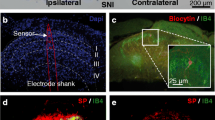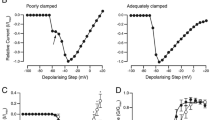Electrophysiological properties of neurons in the substantia gelatinosa (SG, or lamina II) were studied in vitro in spinal cord slices from 3-to 5-week-old rats. Based on the type of action potentials (APs) firing in response to long depolarization (0.5 to 0.8 sec), neurons were categorized into three types: tonic (APs were generated over the whole duration of the stimulus, n = 26, or 41.2%), adapting (a few APs occurred only at the beginning of stimulation, n = 8, 12.7%), and delayed-firing neurons, DFNs (APs occurred at the end of stimulation, n = 22, 35.1%); 11% of the cells had intermediate properties. Neurons of each type expressed distinct ion currents that were subthreshold for AP generation (< −40 mV). Tonic and adapting neurons either had no subthreshold currents (n = 21, or 61.3%) or expressed T-type calcium currents (n = 13, or 38.7%). All DFNs had outward A-type potassium currents. Statistical analysis confirmed this classification scheme: neurons of each type were differentially distributed in a 3-D parametric space of the main cellular properties. Distributions of tonic and adapting neurons partially overlapped, while that of DFNs differed significantly from both the above groups. It is suggested that DFNs perform a special function in the processing of sensory information; the functions of tonic and adapting neurons might be rather similar to each other.
Similar content being viewed by others
References
C. LaMotte, “Distribution of the tract of Lissauer and the dorsal root fibers in the primate spinal cord,” J. Comp. Neurol., 172, 529–561 (1977).
A. R. Light and E. R. Perl, “Differential termination of large-diameter and small-diameter primary afferent fibers in the spinal dorsal grey matter as indicated by labelling with horse-radish peroxidase,” Neurosci. Lett., 6, 59–63 (1977).
E. R. Perl, “Pain and nociception,” in: Sensory Processes, I. Darian-Smith (ed.), Am. Physiol. Soc., Bethesda (1984), pp. 915–975.
Ramon y Cajal, “Histologie du Systeme Nerveux de l'Homme et des Vertebres,” 1, Maloine, Paris (1909).
S. Gobel, “Golgi studies of the substantia gelatinosa neurons in the spinal trigeminal nucleus,” J. Comp. Neurol., 162, 397–416 (1975).
A. J. Todd and S. G. Lewis, “The morphology of Golgi-stained cells in lamina II of the rat spinal dorsal horn,” J. Anat., 149, 113–119 (1986).
J. A. Beal, “Identification of presumptive long axon neurons in the substantia gelatinosa of the rat lumbosacral spinal cord: A Golgi study,” Neurosci. Lett., 41, 9–14 (1983).
T. J. Grudt and E. R. Perl, “Correlations between neuronal morphology and electrophysiological features in the rodent superficial dorsal horn,” J. Physiol., 540, 189–207 (2002).
A. R. Light, D. L. Trevino, and E. R. Perl, “Morphological features of functionally defined neurons in the marginal zone and substantia gelatinosa of the spinal dorsal horn,” J. Comp. Neurol., 186, 151–172 (1979).
M. Yoshimura, and T. M. Jessel, “Membrane properties of rat substantia gelatinosa neurons in vitro,” J. Neurophysiol., 62, 109–118 (1989).
A. M. Thomson, D. C. West, and P. M. Headley, “Membrane characteristics and synaptic responsiveness of superficial dorsal horn neurons in a slice preparation of adult rat spinal cord,” Eur. J. Neurosci., 1, 479–488 (1989).
J. A. Lopez-Garcia and A. E. King, “Membrane properties of physiologically classified rat dorsal horn neurons in vitro: correlation with cutaneous sensory afferent input,” Eur. J. Neurosci., 6, 998–1007 (1994).
R. Ruscheweyh and J. Sandkuhler, “Lamina-specific membrane and discharge properties of rat spinal dorsal horn neurons in vitro,” J. Physiol., 541, 231–244 (2002).
I. V. Melnick, S. Santos, K. Szokol, et al., “Ionic basis of tonic firing in spinal substantia gelatinosa neurons of rat,” J. Neurophysiol., 91, 646–655 (2004).
I. V. Melnick, S. Santos, and B. V. Safronov, “Mechanism of spike frequency adaptation in substantia gelatinosa neurons of rat,” J. Physiol., 559, 383–395 (2004).
S. Santos, I. V. Melnick, and B. V. Safronov, “Selective postsynaptic inhibition of tonic-firing neurons in substantia gelatinosa by μ-opioid agonist,” Anesthesiology, 101, 1177–1183 (2004).
D. M. Campbell and P. K. Rose, “Contribution of voltage-dependent potassium channels to the somatic shunt in neck motoneurons of the cat,” J. Neurophysiol., 77, 1470–1486 (1997).
J. Magistretti, M. Mantegazza, M. de Curtis, and E. Wanke, “Modalities of distortion of physiological voltage signals by patch-clamp amplifiers: a modeling study,” Biophys. J., 74, 831–842 (1998).
S. A. Prescott and Y. de Koninck, “Four cell types with distinctive membrane properties and morphologies in lamina I of the spinal dorsal horn of the adult rat,” J. Physiol., 539, 817–836 (2002).
P. D. Ryu and M. Randic, “Low-and high-voltage-activated calcium currents in rat spinal dorsal horn neurons,” J. Neurophysiol., 63, 273–285 (1990).
Y. Lu and E. R. Perl, “A specific inhibitory pathway between substantia gelatinosa neurons receiving direct C-fiber input,” J. Neurosci., 23, No. 25, 8752–8758 (2003).
Y. Lu and E. R. Perl, “Modular organization of excitatory circuits between neurons of the spinal superficial dorsal horn (laminae I and II),” J. Neurosci., 25, No. 15, 3900–3907 (2005).
S. F. Santos, S. Rebelo, V. A. Derkach, and B. V. Safronov, “Excitatory interneurons dominate sensory processing in the spinal substantia gelatinosa of rat,” J. Physiol., 581, 241–254 (2007).
I. Melnick, N. Pronchuk, M. A. Cowley, et al., “Developmental switch in neuropeptide Y and melanocortin effects in the paraventricular nucleus of the hypothalamus,” Neuron, 56, No. 6, 1103–1115 (2007).
A. Ribeiro-da-Silva, E. P. Pioro, and A. C. Cuello, “Substance P-and enkephalin-like immunoreactivities are colocalized in certain neurons of the substantia gelatinosa of the rat spinal cord: an ultrastructural double-labeling study,” J. Neurosci., 11, No. 4, 1168–1180 (1991).
Author information
Authors and Affiliations
Corresponding author
Additional information
Neirofiziologiya/Neurophysiology, Vol. 40, No. 3, pp. 191–198, May–June, 2008.
Rights and permissions
About this article
Cite this article
Melnick, I.V. Physiological types of substantia gelatinosa neurons in the rat spinal cord. Neurophysiology 40, 161–166 (2008). https://doi.org/10.1007/s11062-008-9030-7
Received:
Published:
Issue Date:
DOI: https://doi.org/10.1007/s11062-008-9030-7




